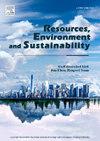Bio-based flame retardants derived from forest industry — An approach towards circular economy
IF 12.4
Q1 ENVIRONMENTAL SCIENCES
引用次数: 0
Abstract
Several environmental studies on conventional flame retardants (FR) have shown them as presistent chemicals that may end up being environmental and health hazards. The advancement of eco-friendly FRs is accelerating due to the needs of improved safety and environmental sustainability. Developing bio-based FR composite materials is crucial due to their regenerable resources, low toxicity, controllable biodegradability, and versatility in application. This review examines recent advancements in utilizing forest industry products, including cellulose and nanocellulose, along with byproducts like lignin and hemicellulose. It also addresses valorized organic waste streams of pulp industries, such as tannins and biopolyols, in the creation of materials that exhibit flame retardancy in polymers and textiles. The review demonstrates functionalization methodologies, qualitative and quantitative characterization carried out on their flame retardant properties following an overview of the FR mechanisms. Finally, the opportunities and challenges for the future development of bio-based FRs are briefly identified, emphasizing on the need of utilizing waste materials as chemical precursors that can alleviate prevailing ecological concerns and open a new set of possibilities in material development in a circular economy.

来自森林工业的生物基阻燃剂——走向循环经济的途径
几项关于传统阻燃剂(FR)的环境研究表明,它们是持久性化学品,最终可能对环境和健康造成危害。由于提高安全性和环境可持续性的需要,生态友好型反应堆的发展正在加速。生物基FR复合材料具有资源可再生、毒性低、可生物降解性可控、应用广泛等特点,因此开发生物基FR复合材料至关重要。本文综述了利用森林工业产品的最新进展,包括纤维素和纳米纤维素,以及木质素和半纤维素等副产品。它还解决了纸浆工业的有机废物流,如单宁和生物多元醇,在聚合物和纺织品中表现出阻燃性的材料的创造。概述了阻燃机理后,综述了功能化方法,对阻燃性能进行了定性和定量表征。最后,简要地确定了生物基燃料燃料未来发展的机遇和挑战,强调需要利用废物作为化学前体,这可以缓解普遍的生态问题,并在循环经济中开辟材料开发的一系列新的可能性。
本文章由计算机程序翻译,如有差异,请以英文原文为准。
求助全文
约1分钟内获得全文
求助全文
来源期刊

Resources Environment and Sustainability
Environmental Science-Environmental Science (miscellaneous)
CiteScore
15.10
自引率
0.00%
发文量
41
审稿时长
33 days
 求助内容:
求助内容: 应助结果提醒方式:
应助结果提醒方式:


